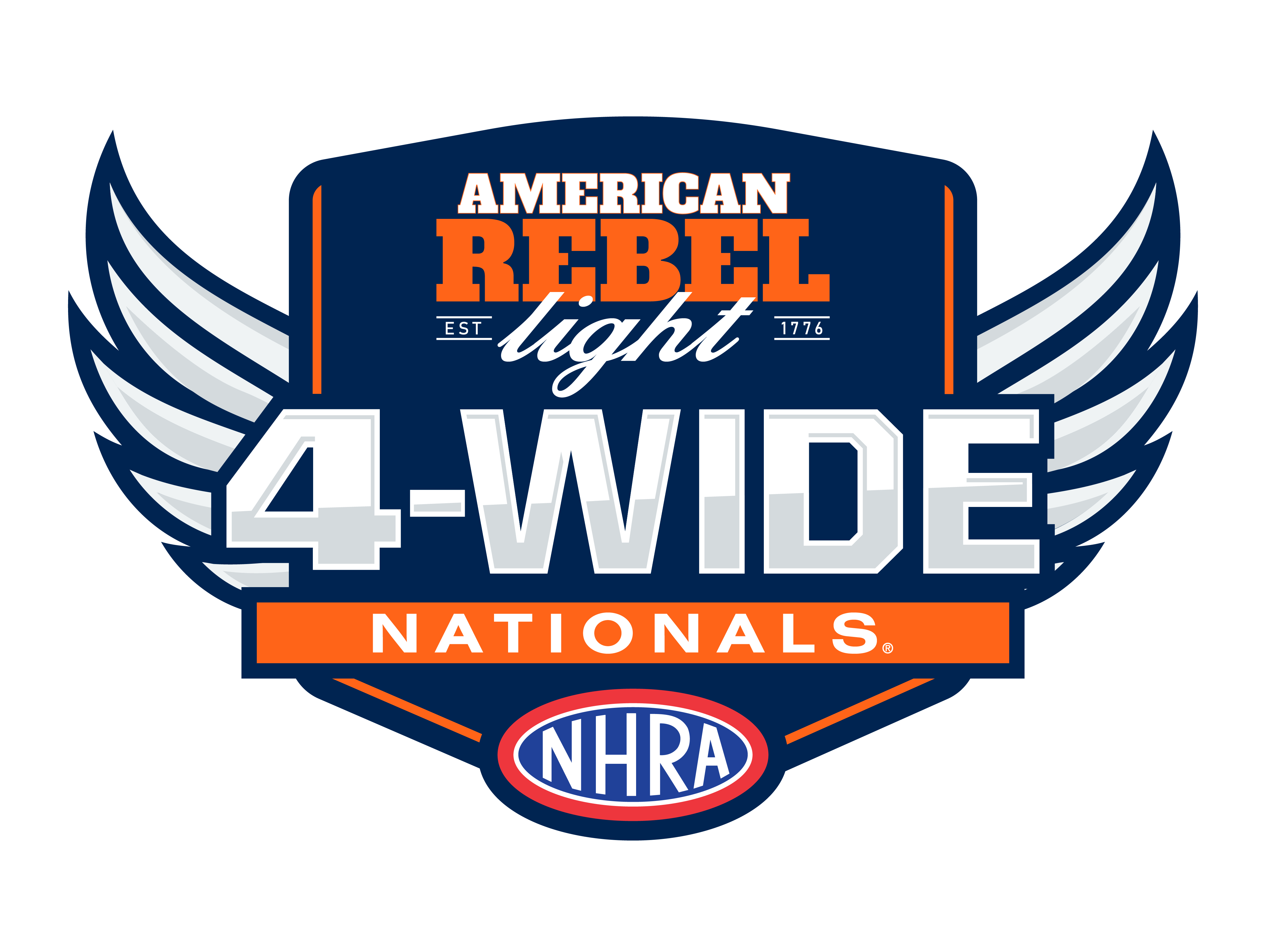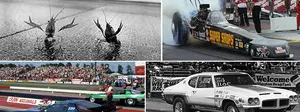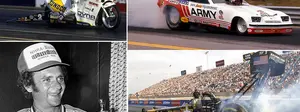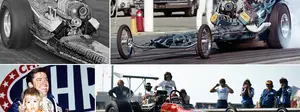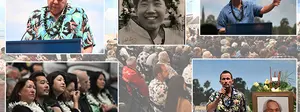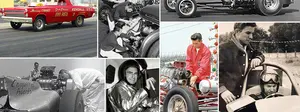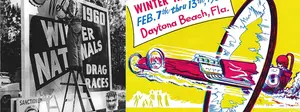

Just another day with the legends
 |
Last weekend’s 50th anniversary Auto Club NHRA Finals was steeped in nostalgia, with vintage-car displays, Cacklefests, and, the highlight for me, more Legends chats, this time involving “TV Tommy” Ivo, Ed “the Ace” McCulloch, Tom "the Mongoose” McEwen, Kenny Bernstein, Shirley Muldowney, Don "the Snake” Prudhomme, and “Big Daddy” Don Garlits, with the equally legendary Dave McClelland as the emcee.
Everyone who came got one of the cool "credentials" shown at right, which also served as an "admission ticket" to the autograph session later in the day ... no ticket, no autograph session.
Unlike the lengthy shows at this year’s Chevrolet Performance U.S. Nationals, the presentations at the Finals were much shorter. Originally discussed as being themed toward the drivers recounting their great moments from World Finals events past, McClelland freelanced a little and also got them to talk about themselves and their careers as a whole.
As inevitably becomes the case, a lot of familiar ground is covered for the newbies in the audience, but I never grow tired of hearing it, never knowing when will be the last time I’ll hear them tell those old chestnuts and not willing to be absent for one chance I have. Folks like you and me have heard the stories time and again (or read them here), so I’ll skip repeating them, but there were still great little sound-bite nuggets to share that I’ve seldom or, in some cases, never heard.
Ivo kicked off the deal at 10 a.m., which is pretty funny to those of us who know that his day usually begins as the sun is going down and ends when it’s coming up (“Ivo time,” as he likes to call it. “I have a little vampire in me,” he admits.) The 78-year-old hero of yours, mine, and especially himself likes to joke that I-V-O stands for “I’m Very Old,” but his energy was still as young as ever.
 |
 |
Of his famous rollover top-end crash at the 1974 Winternationals, Ivo recalled, “When it first happened, it was absolutely sheer terror. I wasn’t even worried about getting hurt because I knew that was it. That was curtains. I read a book somewhere where someone falling out of a building [said] on the trip down, it was kind of pleasant [he obviously survived the fall to share his tale]. When this thing went over, it wasn’t exactly pleasant, but when you decide in your own mind that ‘That’s it,’ you get a euphoric feeling. It just killed the car. It blew it up on the inside, and when it rolled over, it ate up everything on the outside, but I wouldn’t have missed it for the world. It was worth the price of admission. The only thing that made me mad was that it scared me so bad that I closed my eyes and missed the whole show.
“Those old steel guardrails would grab you and eat your car alive. That’s one of the problems of being a pioneer: You get arrows in your ass.”
Ivo, on why he wanted to race: “The movies I’d done for 20 years; I wanted to go racing. Also, I was 115 pounds soaking wet, and those [firesuits] were Robocop outfits I could strap on and go racing against the varsity guys.”
McCulloch was up next, and “the Ace” looked and sounded good. I had the chance to spend some time with him the day before in the tower – where he was hanging with Bill Doner; talk about a great pair to listen to -- to talk about both the past and the present. He’s incredibly introspective about his career and up to speed on today’s group of drivers. I need to sit him down someday to get some of this on the record.
McClelland asked which he preferred, Top Fuel or Funny Car. (Interesting to note that six of the seven legends – Garlits was the exception – drove both in their careers.) “Funny Cars, you can’t see anything; a dragster you see everything. You manhandle a Funny Car; you finesse a dragster. Either way, if it burns nitro, I’m good to go,” he answered.
He noted that a lot of people associate him with the Northwest – with good reason, as I’ll explain – but he was actually born and raised in Visalia, Calif., 45 minutes north of Bakersfield, where his family farmed the San Joaquin Valley. They moved to Portland, Ore., right when he finished high school, and before long, he became a racer, teaming up with Jim Albrich on the Northwind Top Fueler that he claims neither wanted to drive, which was kind of shocking to me to know that such a driving hero might never have ended up behind the wheel.
“I never really wanted to drive,” he confessed. “I was always more interested in the mechanical end of the cars, building them, working on them.”
They had built the car for Bob Haines, who ended up driving instead of Larry Stellings. Dave Jeffers drove the car for them for a while, but he was based in Southern California, and flying him up to the Northwest for dates got to be too expensive, so it had to be either McCulloch or Albrich behind the wheel, and when Albrich’s wife vetoed him doing it, suddenly McCulloch was a driver. And a damned good one.
On June 13, 1965 – the date is etched in his brain – McCulloch beat Pete Robinson in Woodburn, Ore., for the Drag News No. 1 spot. “That’s when people heard of Ed McCulloch,” he said. It wasn’t long after that that Seattle-area sportswriter Jim Cooper wrote a headline after McCulloch beat Jerry “the King” Ruth that read “What beats a king but an ace?” And a nickname was born.
“When my driving career was over, it was pretty easy to make the transition to being a crew chief,” he added but noted that he wasn’t a big believer in the early data recorders that printed their results rather than displayed them on a monitor. “You used to roll this paper out -- it looked like a piece of toilet paper three feet long -- and we’d put two runs [on top of each other] and hold it up to the light to try to look at them. I remember thinking, ‘This computer deal will never fly.’ “
Of his career, he concluded, “We had a helluva time. It was tough competition. We didn’t have any money. We were just making enough money to get to the next race and keep the lights turned on, but we had a good time.”
 Horse lover and would-be cowboy McEwen |
The fabled “Mongoose” was next up and talked about his career with the successful Albertson Olds car and his less successful initial stint with the rear-engine Hemi 'Cuda that took flight at Lions Drag Strip on one of its first runs.
"All of a sudden, I’m seeing sky, and I’m not sure what’s going to happen next, but I know it’s probably not going to be good,” he said. “I shut the engine off and opened the chutes. It rolled over real smooth and came down on its side in the lights and slid down the track, then onto its roof -- it ground through the roof and caught the headliner on fire.”
Snake bite, Part 1: “Prudhomme got the nickname ‘Snake,’ and he’ll tell you it’s because of his lightning reflexes, but I think it was because of his attitude.”
Snake bite, Part 2: “When they first presented [the Snake & Mongoose script] to Hollywood, they didn’t think it was exciting enough because they’re not drag racing people. Prudhomme wanted to make it more X-rated, so I was going to be the drunk, dope-smoking, bad father, womanizer, [BSer] who raced on the weekends and got beat by him, and he was going to be the preacher with the wife and the daughter and was perfect.”
Asked by McClelland what he would have been had he not been a drag racer, McEwen answered obliquely, “Some kind of a cowboy,” which raised some eyes until he went on to explain, “I had horses from the time I was 16, and I always liked country-western music and that kind of stuff. I even went to veterinarian school before I went to college. My mother was so mad at me when I quit college: ‘You’re just going to be another drag race bum,’ she said. ‘You’re going to end up like your father [a Navy test pilot killed in the line of duty when McEwen was 2].' She’d never come to the races, but she’d watch me on TV and tell her friends all about me.”
 |
Bernstein showed up California casual, in shorts, still in great shape (he still walks every day, a habit he started with longtime friend McClelland after “Big Mac” had heart problems a few decades ago), and covered a wide variety of topics, from his early years in Funny Car to his days running an IndyCar team.
“It was a tough game when I started,” he said of his first flopper years. “It took me a couple of years to get going. 1981 was a good year with Ray Alley as my crew chief, but Dale Armstrong came aboard in 1982, and after struggling a couple of years, he found the magic that he was so capable of tapping; it really put us on the map, and that continued into Top Fuel with the 300-mph run in 1992.”
“Another Dale Armstrong invention” was how Bernstein described the notorious Batmobile Buick LeSabre Funny Car body that Armstrong craftily designed within the letter (but not the spirit) of the existing rules in 1987.
“He told me what he wanted to do, and I told him, ’Well, the rules are pretty much open; you don’t have any reason not to,’ " recalled Bernstein. “We had to build the plug and the mold before the first body ever gets kicked out, so it was a big, expensive proposition. I told him to tell me when we got to that point so I could take a look at it.
“So [when the first body was done], I go over there and look at it and say, ‘What in the world is that?’ I couldn’t even recognize it as a body. It was supposed to be a Buick, but I have no idea where that Buick came from. I said, ‘Oh my god; we’re in serious trouble; this is going to be tough. We’ve got to get NHRA down here; this is not going to be easy.’ Dallas Gardner, Carl Olson, Steve Gibbs, and three or four other guys came to see it, and you could hear a pin drop; they were astonished. ‘This is going to be a Funny Car body?’ They said to me, ‘We’re going to have some lunch and think about this.’ I said, ‘I’ve got $300,000 in this; go have a big lunch.’ They came back and told me I could run it for a year.”
About Roberto Guerrero winning the pole at the 1992 Indy 500 in Bernstein's car then spinning out on the parade lap, Bernstein refused to throw him under the bus all these years later. “It wasn’t really his fault, even though it looks that way even today,” he noted, citing the unusually cold conditions that led to cold tires and the massive and quick turbocharged power boost that came from the Buck engines after even a light tap on the throttle.
 |
Bernstein received a huge round of applause – I think even he was surprised – and the cheers kept on coming when Muldowney stepped to the stage after her introductory video. True to fashion, she pulled no punches. Here are just some of the highlights:
“In 1971, we won the first Funny Car meet we ever entered, with Jack Muldowney turning the screws and wrenches,” she remembered. “We went to Lebanon Valley, which was in full bloom, and there they were: the Ramchargers, Brutus, the Tasca team – anyone who was anyone was there – and they all went home losers. That was the beginning of a long war, but I liked what I was doing, and it started to pay.”
“I loved driving that Funny Car, I really did – except when it was on fire. I had some blazers. [My crew] would try all kinds of new innovations … and I was kind of like a sitting duck and not smart enough to realize that I was probably where I shouldn’t be. When it would push out the gaskets, immediately you’d have 14 quarts of nitrated oil on the exhaust, and guess where it went – this way [pointing to herself]. That got very old.”
“I acquired my [Top Fuel] license, which was no real effort because I’d already run well over 200 mph, and Tommy Ivo signed for my license – willingly – and Don Garlits signed for it because he figured, ‘I’m going to get in on this exposure; she’s not going anywhere.’ He knew everyone would want to book the girl who was beating the boys, and he would tell the promoters, ‘If you’re going to book her, you have to book me.’ There’s always been a method to his madness.”
On her AHRA Top Fuel championship: “It wasn’t softball as compared to hardball [with NHRA events]. They were all there: Garlits, Tharp, all the guys who were tough to beat were at those AHRA races because they thought it was easy money – until I drove through the gate. I was not popular.”
By the numbers: “They were fun years. They were rewarding years. They were not that profitable; everything that came in the right hand went out the left.”
Asked about what she’s doing now – she recently moved from Michigan to North Carolina to be near longtime friend and ally Doug Herbert – Muldowney got into the mode she probably once reserved for her toughest dragstrip enemies, on and off the track: “I’ve always had a love for animals. Right now, I fight very tough, dirty, mean – roll-in-the-dirt fight – over animal rights and animal abuse.” She loves her two Chihuahuas and answered the question on the minds of some as to why she was wearing two watches. The right watch was California time; the left watch was” Chihuahua time” back home, so she could monitor their well-being.
 Don Prudhomme thinks John Force (above) is the man now but that "Big Daddy" (below) was the hero of their generation. |
 |
Prudhomme came to the stage after his introductory video – which showed his first-in-the-fives run at the 1975 World Finals – and, in typical mock-cocky “Snake” fashion, proclaimed, “Pretty good, wasn’t I?”
McClelland asked him about the 1974 Finals, where Shirl Greer won the world championship after a qualifying fire, and his role in getting Greer back on track, which he downplayed.
“All I knew was he was a really nice guy, and he needed a hand,” he said. “Shirl was a lot older than me; I was just a pup coming up [sorta true, I guess; Greer was 40, Prudhomme 33].
“Back then, the world championship didn’t really mean anything. It didn’t pay a whole lot,” he explained. “Winning a national event, yeah, but winning the championship wasn’t recognized that much at the time because we had to run some goofy deals [a mixed national and divisional schedule]. We were making our living out on the road touring. The following year, Winston came into the sport, and they brought in lots of money. They put up $25,000 for the winner of the world championship, and guess who won it? You’re looking at him. And for three years after that. I had my day in the sun. It was a good run. Great times. We came up in the entire best time for drag racing.”
Asked how he’s handling his post-racing retirement, Prudhomme said, “I had to start a whole new life. I drag raced for 50 years, and it took me about two or three years of nitro rehab to cut down, but I’m still a gearhead.”
Comparing the drivers of his era to those today, Prudhomme generously asserted, “I’d say that the guys and girls today are better drivers than we were doing it. They’re in better shape, they have better reaction times, they have a specific job to do. When Tony Schumacher drives that car, his most important job is leaving the starting line. They could go to the other end of the track with the front wheels way up in the air and make it through, but if they were late, you’d call them ‘a no-driving son of a bitch.’
“When we drove, yeah, you had to be on time, but you got out of the car at the other end and said, ‘We’ve got to put more weight on the clutch’ or ‘We have to do this or that,’ which is why I like to think that guys like Garlits and myself were quite successful because we knew how to tune the car. Today [because of data loggers], the [drivers] come back to the pits, and for the most part, they don’t say anything – they better not because the crew chief will slap them. You had to know what the car was doing, what the pistons looked like – if it was running lean or rich or if it needed more clutch.
“John Force has all the records today, and I love him, and let’s say he’s the best racer today, but for my generation, Don Garlits was amazing. He could weld the car, build the engine, tow it across the country, pull it out of the trailer, and set records and kick everybody’s ass. He was amazing.”
 |
Garlits was up last, and he and McClelland spent a lot of time talking about his battery-powered effort to breach the 200-mph barrier, with “Big” championing them as the cars of the future for being neighbor friendly. “They’re quiet, but they’re exciting to watch; they do burnouts and everything but make the noise,” he said. He envisions a national event schedule where the teams would have to run their electric cars instead of their nitro cars so they don’t disturb the local communities at events like Pomona and Englishtown where the tracks are close to homes.
He’s clearly geeked up on the technology and its possibilities and for the chance to tinker once again.
“These [modern Top Fuelers] are all spec cars; I have no interest in anything like that,” he proclaimed. “If I can’t come back to the dragstrip every week with a change or some new idea, I ain’t interested. I’m like Dr. [Edward] Teller, the father of the hydrogen bomb, when they asked him about fusion, and he said [imagine Hungarian accent], ‘If it does not explode, I’m not interested.’ If I can’t make changes to my car and come back here next week with something different, I ain’t interested.”
His next shot at 200 on batteries – to match his first 200 on nitro -- will come in early December when he comes back from England, where he’s being inducted into the British Drag Racing Hall of Fame. Garlits added that he gets letters from all around the globe and invitations to take the car everywhere to display or run.
Speaking of “around the globe,” one of Garlits’ funniest stories involved his irrepressible crew chief, T.C. Lemons. “We used to barnstorm all over the country, running three or four times a week, and Tommy Lemons would tell me, ‘You’ve got to quit booking races [by] looking at the globe; you need to look at an actual map,’ ” said Garlits, with a laugh. “On the globe, it didn’t look that far from Florida to New York."
Like most of the others, Garlits was asked by McClelland what he would have been had he not been a drag racer. “My mother would have liked me to be an accountant,” he said, “but my stepfather stepped in and said, ’Don, you love cars, that’s what you should do,’ so I quit my job at the big department store making $39.50 a week and went to work in a body shop for $22.50. My mother had a fit, and my girlfriend never spoke to me again. It’s OK; I got a better girlfriend and a wife [Pat] out of it.” He went on to start his own garage, then a speed shop, then a Hall of Fame career.
Even though the shows were shorter than the Indy shows I reviewed here, I still enjoyed them. McClelland took a different tack than Indy emcee Bob Frey, and they’re both the best in the business, trusted and respected by those they interview, which allows them to ask the questions you and I couldn’t or wouldn’t.
 |
On a side note, we had our new The History of the NHRA World Finals book for sale at the event (buy yours here!), and I decided that I’d try to get the legends to autograph four of the books as giveaways at the NHRA Membership Hospitality Center tent Sunday, which gave me the fun opportunity not only to welcome each of the legends, but also to spend a little time with each backstage while they signed the books. They each also received a free copy of the book as National Dragster’s gift to them.
They were all very gracious, even though they’d already signed their names a zillion times. I practically had to tow them backstage through the sea of admirers that stopped them every two feet for autographs – which they courteously signed even though there was a planned autograph session later in the day – to get their signatures. I’ve never been a big autograph seeker – trying to pretend I’m the cool, professional reporter instead of the supercharged fan I really am – but somehow, a fifth book was also there for them to sign, which they did.
I must have “accidentally” put my copy down there next to the others. Lucky me.







